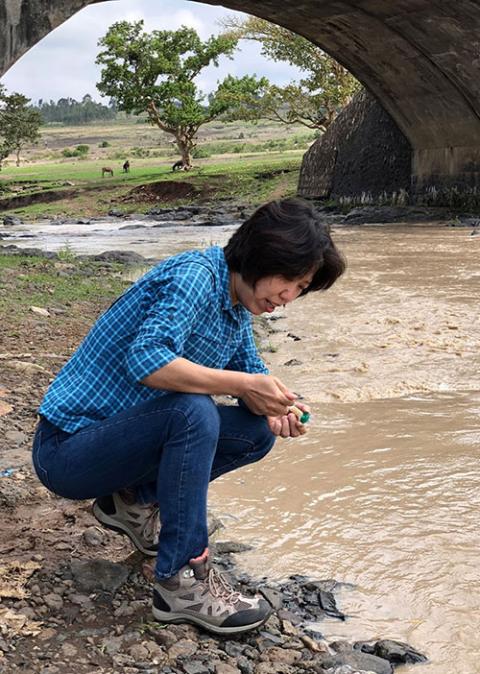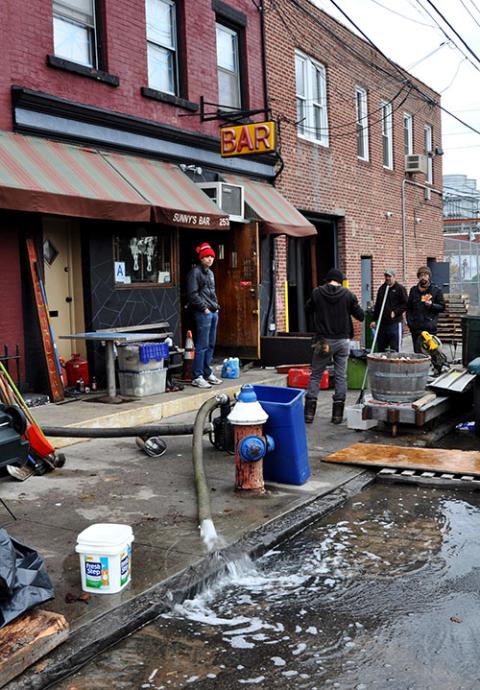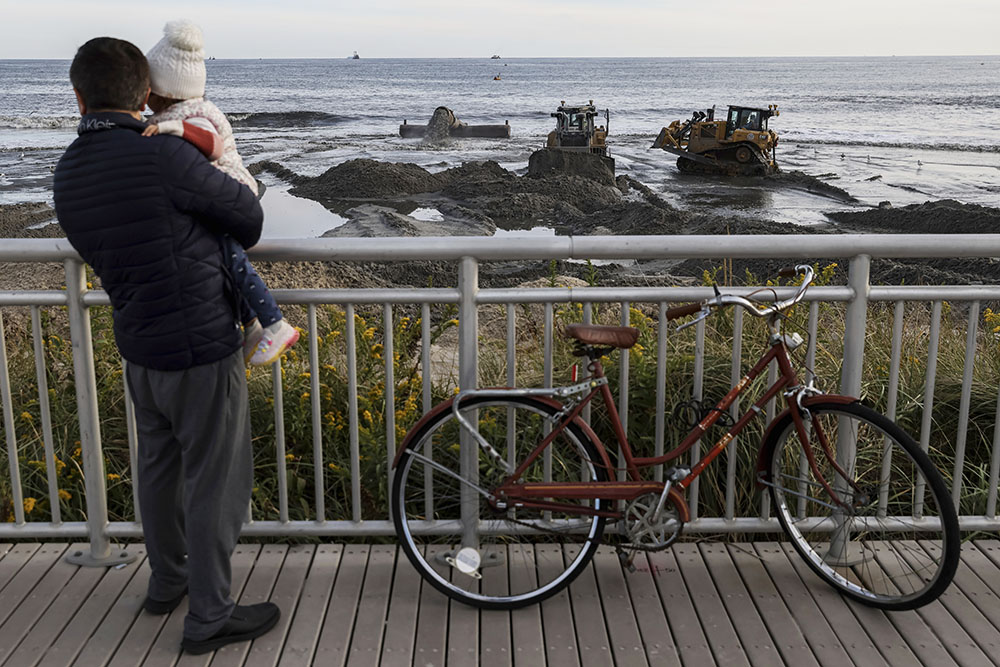
People watch sand dredging work Oct. 22 in the Far Rockaway neighborhood of the Queens borough of New York. The U.S. Army Corps of Engineers' Atlantic Shorefront Resiliency Project aims to construct a reinforced dune system designed to block storm surge, as happened in this area 10 years ago with Superstorm Sandy. (AP/Julia Nikhinson)
Don Riepe lives within a short walk of the A Train, the quickest way to get to Harlem, according to Duke Ellington's famous song.
Still, he is far from the urban scene, here in this enclave within the New York City limits but usually described as a kind of New England fishing village, the only inhabited island on Jamaica Bay. From Riepe's porch, he can see the Manhattan skyline. The water from the bay laps up to his house, so his conservation work literally moves right to his home office. Everyday Edgar the Egret, as Riepe has dubbed his visitor for the past decade, comes for a visit. Edgar is rewarded with a few slices of fish from Riepe's hand.
It is an idyllic nature scene.
But Riepe, a former manager of the Jamaica Bay Wildlife Refuge for the National Park Service, an active conservationist, former high school teacher and worker for the Audubon Society who earned a graduate degree in environmental science from the University of New Hampshire, knows nature along the water is not always so placid. He lives with the tides and the danger of flooding. He will, on occasion, move his furniture upstairs. When heavy rains and high tides come, he and the other 3,000 inhabitants of Broad Channel move their cars up to the slight incline in the middle of the main thoroughfare.
However, nothing could have prepared him for Superstorm Sandy, which blew through the island Oct. 29, 2012, with a path of destruction through New York's heavily populated waterfront areas. A total of 44 people lost their lives in the city, nine of them from Rockaway, just across a short bridge from Broad Channel.
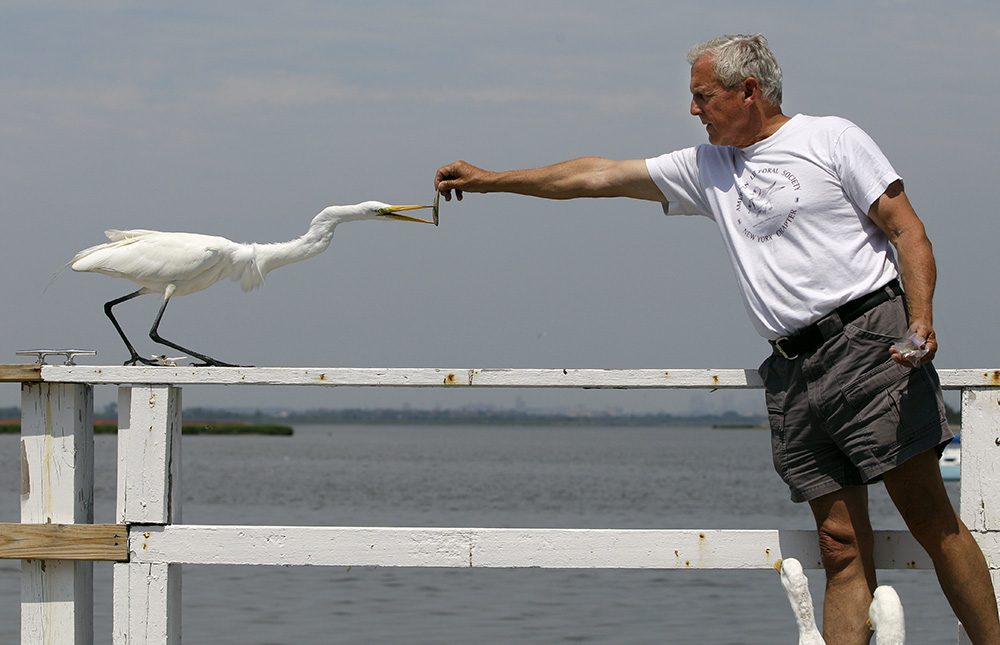
In July 2012, a few months before Superstorm Sandy, Don Riepe feeds a small fish to a great egret that regularly visits his dock at Broad Channel on Jamaica Bay in New York. (AP/Kathy Willens)
"This community was a lake. People lost a lot," Riepe said, noting that his own modest home along the bay was demolished as more than 5 feet of water rushed through.
Sandy was dubbed a once-in-a-century event, a meteorological quirk when near hurricane-force winds and extremely high tides brought disaster. In Rockaway, where nearly 114,000 people reside, the peninsula, 14 miles long and less than a mile wide in most areas, was overwhelmed as the slim land mass was deluged with the meeting of the Atlantic Ocean and Jamaica Bay. The storm destroyed bungalows and waterfront cottages and damaged massive city housing projects. The waterfront taverns mark the spot where the water crested.
People in Rockaway and Broad Channel are not alone. Some 94 million people live in coastal areas in the United States, nearly 30% of the population. Despite storms like Sandy, and ominous warnings of rising waters, that number keeps going up.
On the Atlantic Coast, from Miami to North Carolina's Outer Banks to Manhattan, planners are trying to figure out ways that large numbers of people can live safely in precarious regions. While scores of communities have rebuilt after natural disasters, global climate change and rising oceans present challenges to long-term planning.
Challenges to long-term planning
For months, residents of Broad Channel and Rockaway mourned their losses. In Broad Channel, noted for its proud isolation, residents were forced to rely on charity food carts and the kindness of strangers.
Riepe was grateful for the help from outsiders. The city Department of Sanitation hauled off the massive debris and an outside Buddhist group gave survivors $600 debit cards. In what is a largely Irish Catholic community, Mormon missionaries provided relief and welcome labor, assisting homeowners and generating goodwill but never asking for conversions.
Advertisement
In the decade since, despite frequent complaints about the sometimes slow-arriving FEMA and private flood insurance assistance, the area is more protected. Houses were raised and sand pumped onto the beach. The Rockaway boardwalk, formerly a quaint wooden structure that Sandy tore apart like it was a collection of toothpicks, has been rebuilt with concrete, another barrier for the threatening ocean.
Grass dunes now line the beach. And backwater marshes are now preserved, allowing more room for water to move away from populated areas. Massive jetties have been constructed into the ocean, rock formations intended to keep beaches filled with barrier sand.
But climate experts argue that these are largely short-term solutions and might well prove to be inadequate in facing the next superstorm.
What was once considered a once-in-century event may be once in a few decades, returning with more force as global waters rise and warm. Sandy, which also hit other New York water communities such as Lower Manhattan, Brooklyn and Staten Island, as well as the New Jersey shore, may be a harbinger of future disasters.
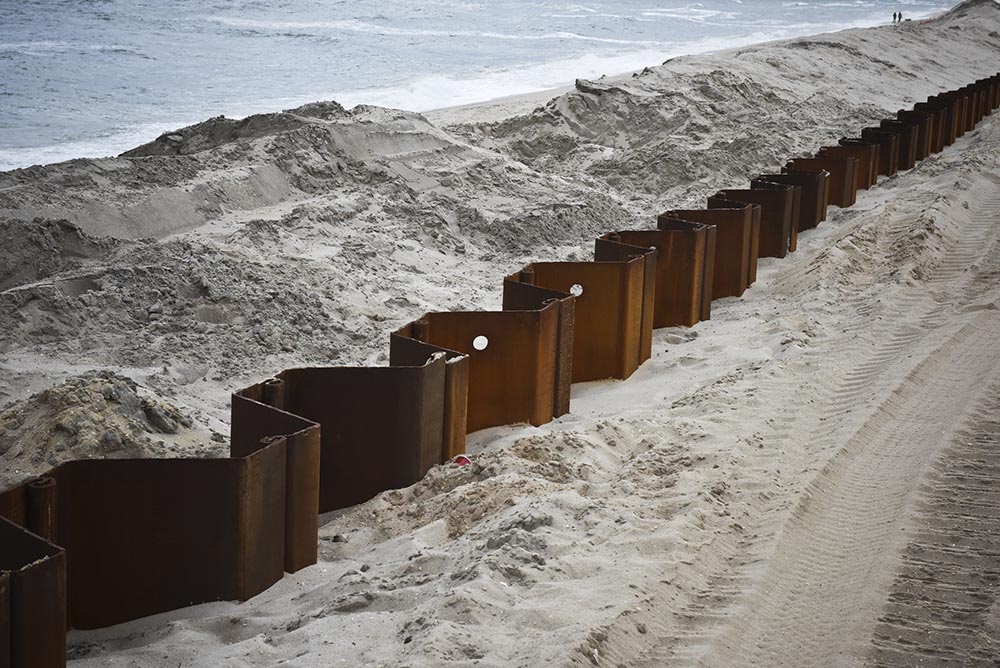
Protective infrastructure can be seen March 19, 2014, along the ocean front in Ocean County, New Jersey. (CNS/The Monitor/Jeff Bruno)
Grand plans, such as a massive gate built between Rockaway and New Jersey, are in the idea stage, but governments are reluctant to embrace the long-term costs. The proposed 6-mile-long gate would close over the waters around New York during big storms. An idea developed by the Army Corps of Engineers, the $119 billion project would help prevent the ravages of another Sandy.
Yet its cost, and environmental concerns that the gate would trap sewage and toxins and threaten the recovery of urban waterways, has stalled the project.
Another idea is to expand Manhattan Island — bringing in more material to build more barriers from the ocean fury. That plan has generated community opposition because of how it would impede waterfront access and valuable open space.
Back-to-normal is misleading
Removed from Sandy's fury by the passing of time, there is a back-to-normal sense here. Many demolished houses have been rebuilt and new gleaming development is taking hold, including filling in with apartments some of the last remaining open space in New York City, valuable beachfront ocean property.
But scientists and urban planners caution that the calm normalcy and bustling development can be misleading. All is not well.
As true throughout the endangered East Coast, coastal regions have done some effective work in delaying the consequences of global water rise, said Shuang-Ye Wu, chair of the geology department and a climate scientist at the University of Dayton.
"Many of the measures are really short-term," she said. "But they don't have so much planning on the long term."
Big and more powerful storms remain on the horizon, and shifting sand, buttressing seawalls and constructing rocky jetties on the ocean shore can only go so far in holding back the water. She said that coastal residents will face more intense storms fed by warmer ocean water.
Even the most expansive and ambitious of the sea defense projects are temporary fixes. Ecologically friendly projects, such as maintaining marsh areas to soak up rising waters, will have only a temporary impact.
Some policy changes can help, Wu said. Flood insurance can reflect the market risk, instead of being government-subsidized. But ultimately, those who live near the water will have to learn to live with the risks, or move, according to Wu.
There is little will to do the latter. Since Sandy hit, the population of people in coastal regions has only gone up.
Particular New York concerns
Catholic climate activist Nancy Lorence agrees that the solutions to coastal flooding lie in the long term. As co-coordinator of the Metro New York Catholic Climate Movement, which includes 11 parishes in the New York City area, she continues to be alarmed at development that relies on short-term fixes.
On a tour of Red Hook, Brooklyn, another neighborhood ravaged by Sandy 10 years ago, she saw that the city is raising land to keep the adjacent East River at bay. Yet to do that, the city has cut down scores of trees that previously provided oxygen and cooling for the urban area.
'We really need to step up our game. New York is very susceptible to what climate change is doing.'
—Nancy Lorence
For Lorence, it is discouraging to see the bare stumps of trees that are valuable in cooling Red Hook, a neighborhood set away in a public transit desert, with a massive public housing project as well as continually gentrifying sections.
"I've learned that we really need to step up our game. New York is very susceptible to what climate change is doing," she said.
It's relatively easy to get people to think environmentally in their personal lives, said Lorence. Her group has put out a carbon fast calendar geared to Lent and sponsored events encouraging lessening the region's carbon footprint. Promoting compost and recycling campaigns are popular. But getting people involved in civic activism is a tall order.
She remembers the Sandy disaster, which blacked out all of Lower Manhattan, causing students she taught English to from Chinatown to deliver food up eight flights of stairs in high rises for their isolated elderly parents, stuck without electricity and working elevators.
There are particular New York concerns in lessening the carbon footprint scientists believe contribute to global warming and rising sea levels. One is to rid the city of old, dirty boilers that heat its apartments and offices.
Preserving wetlands would also help, a particular concern on Staten Island, another area hit hard by Sandy, Lorence said.
She echoed Pope Francis' call in his 2015 encyclical "Laudato Si', on Care for Our Common Home" to re-examine lifestyles, particularly the use of energy.
"The transition is happening, but it's not happening fast enough," she said.
Few are willing to leave
"The water always wins," urban planner Donovan Finn said, repeating a credo of naturalists who study waterfront recovery.
Finn, a professor at Stony Brook University who has carefully followed post-Sandy developments, noted that warnings from climate scientists and from Francis in Laudato Si' are in the collective rearview mirrors of residents as Sandy becomes a decade-old bad memory and the wider political life of the country makes wholesale change seemingly impossible.
"I think the pope's attention to the issue is admirable. But so much is wrapped up in the blue/red polarization," said Finn.
'The water always wins.'
—Donovan Finn
Rockaway and Broad Channel remain isolated enclaves, their inhabitants often suspicious of outsiders. Conservative, largely white communities retain much of the political and planning power.
There is a large Black population historically segregated by the inclusion of massive housing projects brought to the area by Robert Moses, New York's master planner of the 1950s and '60s, as well as Black middle-class homeowners in what is called Far Rockaway.
Finn has spent much of the past decade at planning meetings soliciting community input in areas affected by Sandy. The politics of the outside world make consensus on big decisions difficult, he said.
"It got hard to get people in a room to agree on anything. Every single public meeting became a screaming match and a protest," he said. There were regular complaints that federal FEMA money was slow in coming, and homeowners objected to any plan seen to threaten their property investment.
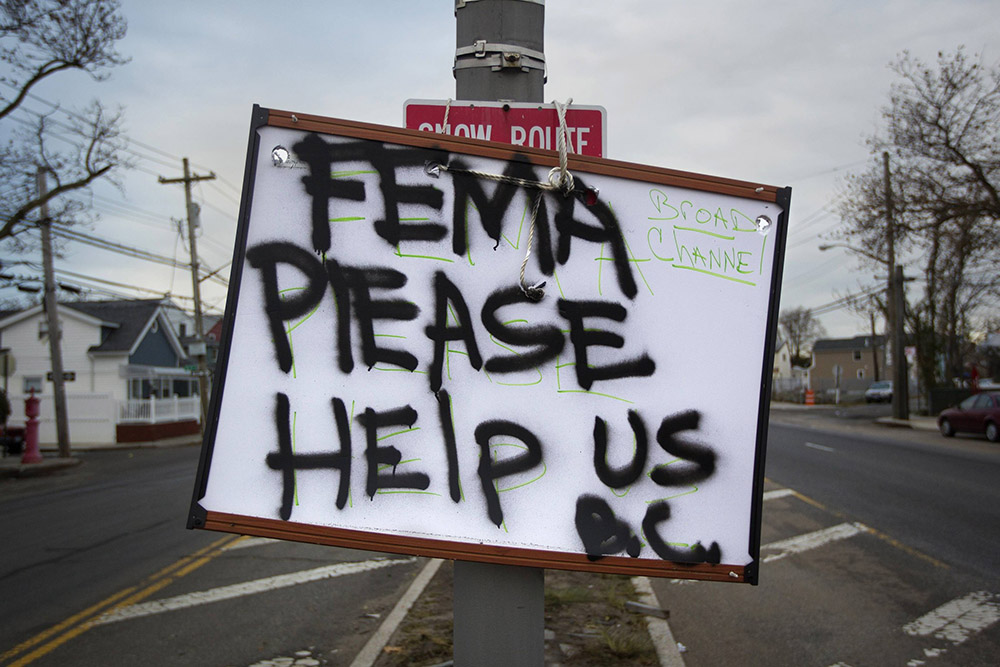
A sign asking for help from the Federal Emergency Management Agency, or FEMA, is seen in the Broad Channel section of the Queens borough of New York Nov. 2, 2012. (CNS/Reuters/Shannon Stapleton)
Outside experts argue that a long-term solution to the flooding issues is to move people away from the shore. But what does provoke widespread agreement across Rockaway and Broad Channel is that few are willing to leave, especially homeowners with deep roots in the sand.
As the specter of Sandy recedes, activists note that perhaps another big storm is the only way to put the issue back on the top of the agenda of government and business.
More development has come to the region, including massive upscale apartment complexes located on the beach. In the warm days of summer, the Rockaway peninsula is swamped by visitors from Manhattan and Brooklyn, coming on the ferry instituted after Sandy hit as the subway system stalled out from the flooding. A new upscale hotel beckons, giving what was a hardscrabble, honky-tonk feel a more Hamptons-like resort tone, at summer peak rates of $650 a night.
Ray Vann, a former Rockaway news reporter and local historian working for a newly elected city council member, one of a handful of Republicans on that body, noted that the area contains pockets, such as Broad Channel, containing one of the last Republican-leaning areas in the city. Donald Trump carried large chunks of the western slice of the peninsula and Broad Channel, one of the few areas of Republican dominance in the city's borders.
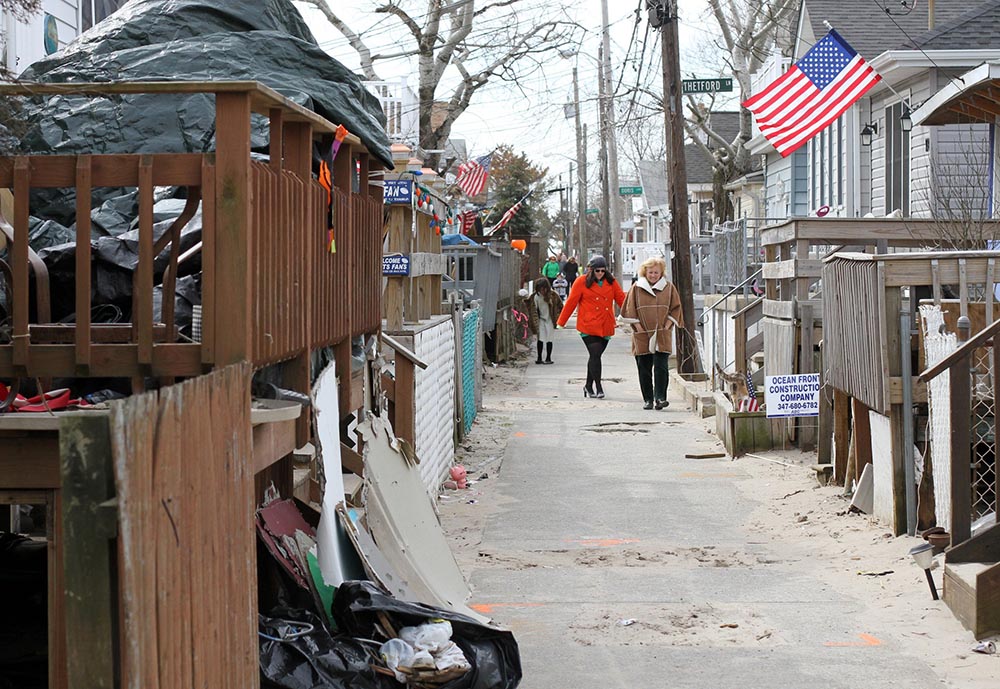
People walk along a sidewalk between damaged homes in the Breezy Point section of the New York borough of Queens March 17, 2013. Breezy Point was devastated by fire and flooding when Hurricane Sandy swept through the region in October 2012. (CNS/Gregory A. Shemitz)
"People in Rockaway are pretty conservative. But when it comes to environmental stuff, it doesn't fit the mode of typical conservatism," said Vann.
The presence of the water on all sides creates an environmental consciousness even in the most conservative precincts. And there's also self-interest, as what have become million-dollar homes sit precariously near potentially rampaging waters.
When the warm summer days take over, it's easy to take in the ocean and bay views, with the orange sunsets over New Jersey keeping thoughts of catastrophic storms far away. But the fall hurricane season and winter winds are never far away.
The threat of another once-in-a-century storm hangs over the region, as the imperative to keep the waters away from the hundreds of thousands who live near the ocean and the bay is creating demands for resources that political leaders have so far been unable to mobilize.
A dedicated naturalist, Riepe noted, "Nature is not nice."

